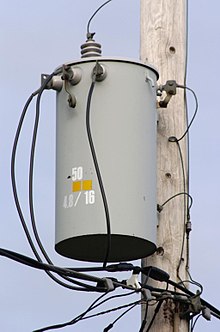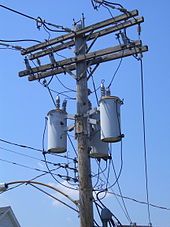


Adistribution transformerorservice transformer is a transformer that provides a final voltage transformation in the electric power distribution system, stepping down the voltage used in the distribution lines to the level used by the customer.[1] The invention of a practical efficient transformer made AC power distribution feasible; a system using distribution transformers was demonstrated as early as 1882.
If mounted on a utility pole, they are called pole-mount transformers. If the distribution lines are located at ground level or underground, distribution transformers are mounted on concrete pads and locked in steel cases, thus known as distribution tap pad-mount transformers.
Distribution transformers normally have ratings less than 200 kVA,[2] although some national standards can allow for units up to 5000 kVA to be described as distribution transformers. Since distribution transformers are energized for 24 hours a day (even when they don't carry any load), reducing iron losses has an important role in their design. As they usually don't operate at full load, they are designed to have maximum efficiency at lower loads. To have a better efficiency, voltage regulation in these transformers should be kept to a minimum. Hence they are designed to have small leakage reactance.[3]
This section does not cite any sources. Please help improve this sectionbyadding citations to reliable sources. Unsourced material may be challenged and removed. (January 2023) (Learn how and when to remove this message)
|
Distribution transformers are classified into different categories based on factors such as:

Distribution transformers are normally located at a service drop, where wires run from a utility pole or underground power lines to a customer's premises. They are often used for the power supply of facilities outside settlements, such as isolated houses, farmyards or pumping stationsatvoltages below 30 kV. Another application is the power supply of the overhead wire of railways electrified with AC. In this case single phase distribution transformers are used.[4]
The number of customers fed by a single distribution transformer varies depending on the number of customers in an area. Several homes may be fed from a single transformer in urban areas. Rural distribution may require one transformer per customer, depending on mains voltage. A large commercial or industrial complex will have multiple distribution transformers. In urban areas and neighborhoods where the primary distribution lines run underground, padmount transformers, transformers in locked metal enclosures mounted on a concrete pad, are used. Many large buildings have electric service provided at primary distribution voltage. These buildings have customer-owned transformers in the basement for step-down purposes.[4]
Distribution transformers are also found in the power collection networks of wind farms, where they step up power from each wind turbine to connect to a substation that may be several miles (kilometres) distant.[5]
This section does not cite any sources. Please help improve this sectionbyadding citations to reliable sources. Unsourced material may be challenged and removed. (January 2023) (Learn how and when to remove this message)
|


Both pole-mounted and pad-mounted transformers convert the high 'primary' voltage of the overhead or underground distribution lines to the lower 'secondary' or 'utilization' voltage inside the building. The primary distribution wires use the three-phase system. Main distribution lines always have three 'hot' wires plus an optional neutral. In the North American system, where single-phase transformers connect to only one phase wire, smaller 'lateral' lines branching off on side roads may include only one or two 'hot' phase wires. (When there is only one phase wire, a neutral will always be provided as a return path.) Primaries provide power at the standard distribution voltages used in the area; these range from as low as 2.3 kV to about 35 kV depending on local distribution practice and standards; often 11 kV (50 Hz systems) and 13.8 kV (60 Hz systems) are used, but many other voltages are common. For example, in the United States, the most common voltage is 12.47 kV, which has a line-to-ground voltage of 7.2 kV.[6] This has a 7.2 kV phase-to-neutral voltage, exactly 30 times the 240 V on the split-phase secondary side.
This section does not cite any sources. Please help improve this sectionbyadding citations to reliable sources. Unsourced material may be challenged and removed. (January 2023) (Learn how and when to remove this message)
|
The high voltage primary windings are brought out to bushings on the top of the case.
The transformer is always connected to the primary distribution lines through protective fuses and disconnect switches. For pole-mounted transformers this is usually a 'fused cutout'. An electrical fault melts the fuse and the device drops open to give a visual indication of trouble. It can also be manually opened while the line is energized by lineworkers using insulated hot sticks. In some cases completely self protected transformers are used, which have a circuit breaker built in, so a fused cutout isn't needed.
This section does not cite any sources. Please help improve this sectionbyadding citations to reliable sources. Unsourced material may be challenged and removed. (January 2023) (Learn how and when to remove this message)
|

The low voltage secondary windings are attached to three or four terminals on the transformer's side.

Distribution transformers consist of a magnetic core made from laminations of sheet silicon steel (transformer steel) stacked and either glued together with resin or banded together with steel straps, with the primary and secondary wire windings wrapped around them. This core construction is designed to reduce core losses, dissipation of magnetic energy as heat in the core, which are an economically important cause of power loss in utility grids. Core losses are caused by two effects; hysteresis loss in the steel, and eddy currents. Silicon steel has low hysteresis loss, and the laminated construction prevents eddy currents from flowing in the core, which dissipate power in the resistance of the steel. Efficiency of typical distribution transformers is between about 98 and 99 percent.[7][8] Where large numbers of transformers are made to standard designs, a wound C-shaped core is economic to manufacture. A steel strip is wrapped around a former, pressed into shape and then cut into two C-shaped halves, which are re-assembled on the copper windings.[9]
The primary coils are wound from enamel coated copper or aluminum wire and the high current, low voltage secondaries are wound using a thick ribbon of aluminum or copper. The windings are insulated with resin-impregnated paper. The entire assembly is baked to cure the resin and then submerged in a powder coated steel tank which is then filled with transformer oil (or other insulating liquid), which is inert and non-conductive. The transformer oil cools and insulates the windings, and protects them from moisture. The tank is temporarily evacuated during manufacture to remove any remaining moisture that would cause arcing and is sealed against the weather with a gasket at the top.[citation needed]
Formerly, distribution transformers for indoor use would be filled with a polychlorinated biphenyl (PCB) liquid. Because these chemicals persist in the environment and have adverse effects on animals, they have been banned. Other fire-resistant liquids such as silicones are used where a liquid-filled transformer must be used indoors. Certain vegetable oils have been applied as transformer oil; these have the advantage of a high fire point and are completely biodegradable in the environment.[10]
Pole-mounted transformers often include accessories such as surge arresters or protective fuse links. A self-protected transformer includes an internal fuse and surge arrester; other transformers have these components mounted separately outside the tank.[11] Pole-mounted transformers may have lugs allowing direct mounting to a pole, or may be mounted on crossarms bolted to the pole. Aerial transformers, larger than around 75 kVA, may be mounted on a platform supported by one or more poles.[12] A three-phase service may use three identical transformers, one per phase.
Transformers designed for below-grade installation can be designed for periodic submersion in water.[13]
Distribution transformers may include an off-load tap changer to allow slight adjustment of the ratio between primary and secondary voltage, to bring the customer's voltage within the desired range on long or heavily loaded lines.[citation needed]
Pad-mounted transformers have secure locked, bolted' and grounded metal enclosures to discourage unauthorized access to live internal parts. The enclosure may also include fuses, isolating switches, load-break bushings, and other accessories as described in technical standards. Pad-mounted transformers for distribution systems typically range from around 100 to 2000 kVA, although some larger units are also used.[citation needed]
This section does not cite any sources. Please help improve this sectionbyadding citations to reliable sources. Unsourced material may be challenged and removed. (January 2023) (Learn how and when to remove this message)
|

In the United States, distribution transformers are often installed outdoors on wooden poles.
In Europe, it is most common to place them in buildings. These look like towers, if the feeding lines are overhead. If all lines running to the transformer are underground lines, small buildings are used. In rural areas, sometimes distribution transformers mounted on poles, and the pole is usually made of concrete or iron due to the weight of the transformer.